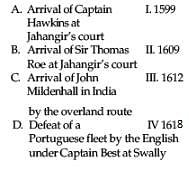Satish Chandra Test: The Mughal Empire- 2 - UPSC MCQ
30 Questions MCQ Test History for UPSC CSE - Satish Chandra Test: The Mughal Empire- 2
The dual rank of ‘Zat’ and ‘Sawar’ was for the first time mentioned in which of the following contemporary sources?
| 1 Crore+ students have signed up on EduRev. Have you? Download the App |
In which language did Babur wrote his memoirs, called “Tuzuk-i-Baburi”?
During the reign of which great Mughal was tobacco introduced in India?
Who among the following murdered Abul Fazl, the official historian of Akbar, at the instigation of Prince Salim in 1602?
Which great Mughal is credited with prohibiting ‘Sati’ unless the widow herself, of her own free will, persistently desired it?
‘Jagir’ of the Mughals is equal to which of the following Sultanate period?
Who wrote the history of Aurangazeb’s reign in total secrecy because of the emperor’s oppositon to it?
What is the correct sequence of the following battles?
I. Battlee of Haldighati
II. Battle of Chausa
III. Battle of Samel
IV. Second Battle of the Panipat
V. Battle of Bilgram
What is the correct chronology of the following events of Akbar’s reign?
I. Abolition of Pilgrim tax
II. Abolition of Jaziya
III. Introduction of Dagh
IV. Issue of Mahjar
V. Proclamation of Tauhit-i-Ilahi
Which of the following were French visitors to the Mughal empire all of whom were in India in 1666?
I. Tavernier
II. Bernier
III. Thevenot
IV. Manucci
Mughal School of Painting is characterised by
I. Excellency in portrait-painting and colour composition.
II. Miniature paintings
III. Keen appreciation of nature
IV. Secular and materialistic
V. Courtly and aristocratic in content.
Pick out the two Persian master-painters who came to India with Humayun and later served under Akbar from among the following:
I. Khwaja Abdus Samad
II. Sayyid Ali Tabreji
III. Farukh Beg
IV. Tamshad
Which of the following concerning Bairam Khan is incorrect?
Which of the following reasons was not responsible for the downfall of Bairam Khan?
Which of the following describes the correct division of Akbar’s empire in descending order?
Which of the following was a measure Akbar took to establish a centralised state structure?
The Afghan ruler of Malwa who fought against Akbar from 1560 to 1562 A.D. was
What was Akbar’s main objective in developing good relations with the Rajputs?
The first Rajput chief to surrender to Akbar was
During the Akbar’s time, the fortress reputed to be the most powerful in Rajasthan was
The Hadas remained high in Akbar’s favour without any matrimonial ties with him. They belonged to
Which is/are true regarding Akbar’s main objectives in going to the Deccan?
Hemu, the Hindu general who led the Afghan forces against the Mughals in the Second Battle of Panipat, was the general of which of the following Sur rulers?
Which one of the following was not a Mughal province in the Deccan during Akbar’s reign?
Akbar’s enlightened religious policy was based on his philosophy of Sulh-i-kul which meant
Arrange chronologically:
I. Construction of Ibadat Khana
II. Promulgation of Din-i-Ilahi
III. Issuing of Mazharnama
|
121 videos|490 docs|176 tests
|


















